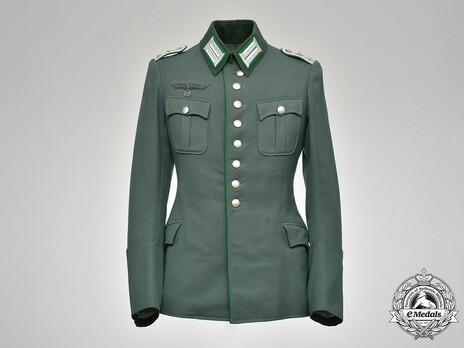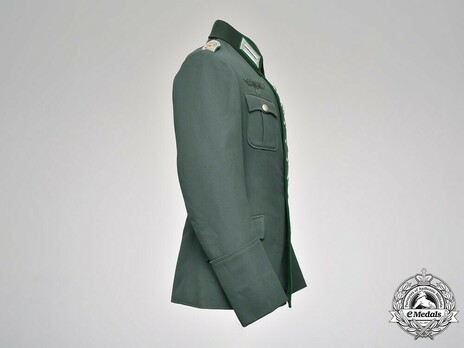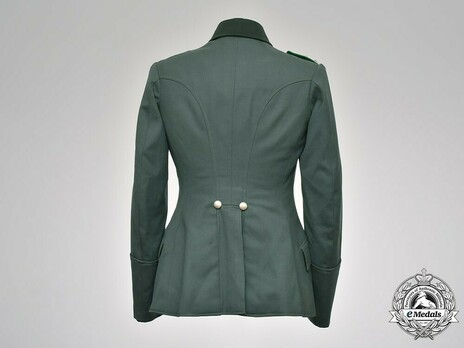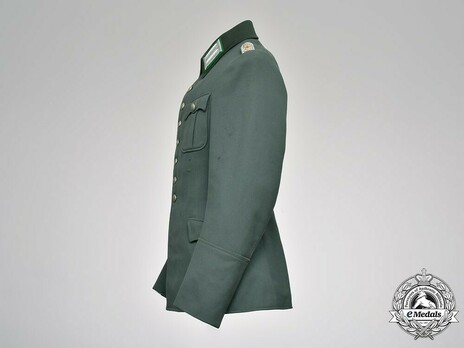German Army Mountain Officer's Old Style Dress Tunic
CATEGORY: Version
SKU: 20.GOR.02.01.01.03.02.007.000
Estimated market value:




Estimated market value:
Heer (Army) Gebirgsjäger (Mountain Troops) officer’s dress tunic, constructed of fine field-grey wool with a rayon interior liner. The collar is flanked on each side by tabs constructed of light green wool bearing dual machine-embroidered silver aluminum bullion wire insignia, measuring 45 mm (w) x 75 mm (l). Each shoulder has a board constructed of cardboard-reinforced light green wool bearing two rows of twisted silver aluminum bullion wire, wrapped around a pebbled, silvered zink button securing the board to the tunic. Each shoulder board also bears two bronzed zink rank pips, indicating that this tunic was worn by a Hauptmann. The cuffs of each sleeve are rolled up to a depth of 170 mm and securely held in place by two pieces of machine stitching. The tunic has four breast pockets, with two on each side, opening with a stylized flap bearing a single reinforced buttonhole meeting a pebbled, silvered, magnetic metal button. Above the top right pocket is a reapplied insignia in the form of a Wehrmacht-style German national eagle clutching a wreathed mobile swastika, constructed of grey aluminum bullion wire, measuring 105 mm (w) x 40 mm (h). The tunic is closed by eight pebbled, silvered, magnetic metal buttons on the right breast flap meeting an equal number of reinforced buttonholes on the left. All magnetic metal buttons on the tunic are stamped on the reverse with “EXTRA FEIN" and the logo of manufacturer F.W. Assmann & Söhne, Lüdenscheid. The breast flaps are also lined with the light green “Waffenfarbe” piping of Wehrmacht Gebirgsjäger units. The lower rear of the tunic has a vertical slit, similarly lined with green piping, met at the top by two unmarked, pebbled, silvered magnetic metal belt hooks. The interior of the tunic features a complete field-grey rayon liner, transitioning into a pinstripe design through the arm. There is a single interior pocket located at the bottom right, opening with a reinforced horizontal flap. There is a further reinforced slit on the bottom left opening into the corresponding exterior pocket. A rayon belt arrangement is found just above the waistband, with each ribbon bearing a magnetic metal buckle. Rayon loops are stitched into each armpit, while the interior of the collar also bears two magnetic metal hooks meeting an equal number of loops on the opposite side, facilitating a flush fit with the wearer’s neck. The tunic is unmarked and measures approximately 442 mm across the shoulders, with an arm length of 620 mm and an overall body length of 695 mm. There is evidence that insignia formerly pinned into the shoulder boards have been removed, and there is minor soiling and fatigue to the exterior wool, but the tunic is in an otherwise near extremely find condition.
The Old Style Service Tunic was designed in the style of its predecessor, the Reichswehr tunic. Later, it was supposed to be replaced by the Field Tunic and Dress Tunic, yet it proved so popular, especially with higher ranks, that it’s wearing out period was extended several times. In fact, it was worn well into the war.
It is field-grey and has either six or eight buttons down the front. The fall-down collar mostly came in field-grey as well, but there are also examples in dark blue-green. On the inside of the collar there are five buttons to attach the neck band. The tunic has two buttoned patch breast pockets with three point flaps. There are two slash pockets on the hips with buttoned slanted pocket flap. On top of that, there is a left side inside pocket. The turn-up cuffs are of the “French” style. The tunic has no tail pocket flaps, but there are two buttons at the back. All buttons are field-grey pebbled buttons.
Compared to NCOs (non-commissioned officers) and EMs (enlisted men), officers wore a tunic made of superior material quality. Their tunics had eight buttons down the front instead of six, and sometimes it came with patch hip pockets.
General ranks wore a tunic with gilt buttons and gilt national emblem. The tunic also features bright red piping down the edge of the front.
Officers wore a special dress tunic that was piped down the front like the General’s tunic, except the piping was in the wearer’s branch colour. NCOs and EMs were also allowed to privately purchase dress tunics with piping, however it is unknown to what extent this was done.
The tunic also came in the form of a denim tunic made from light drill material. It was mainly used for wear during the summer by the lower ranks. It differs from the regular tunic in that it has no lining or cuffs.

Comments
Sign in to comment and reply.


Scroll Top